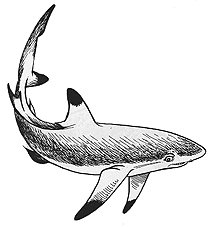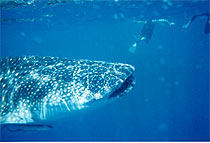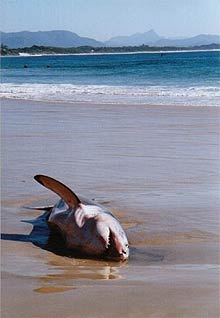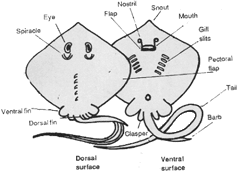 |
|

|
Sharks
and Rays - they're more scared of us!
courtesy Great Barrier
Reef Marine Park Authority |
|
SHARKS
There are many different species of
sharks found on the Great Barrier
Reef. They come in all shapes and
sizes and range from small bottom-feeding
sharks, like cat sharks and wobbegongs,
to the larger more active species
such as tiger sharks and hammerheads.
Most sharks are predators. Their powerful
jaws are filled with rows and rows
of razor-sharp teeth. The first two
rows are used for feeding. The others
are new teeth that will replace the
old ones when they become worn or
drop out.
Each
type of shark has teeth shaped according
to its diet. Sharks with spiky teeth
seize their food (usually fish), sharks
with saw-edged teeth can cut through
the toughest of things, even turtle
shells. Some sharks have crushing
plates rather than teeth in their
mouths and feed on crabs and molluscs.
|

Drawing
courtesy Wet
Paper |
| |
|

Interesting Fact
Whale sharks can grow up to 12 metres and are the
largest living fish in the world. They can be found in the
outer Great Barrier Reef and are annually present at
the Ningaloo Reef, WA .where there is a whale
shark swimming industy. |
Sharks reproduce either by laying eggs in tough, little cases, or by giving birth to fully formed young. When eggs are laid the cases are left to develop among weeds or coral and the young hatch after several months. Some sharks such as nurse sharks and whale sharks produce eggs in cases but these are retained within the body of the mother until the young hatch. Other sharks, like reef sharks, give birth to litters of shark pups after a pregnancy of about ten months. Each shark pup must fend for itself and hunt for its own food as soon as it is born.
Sharks are far more threatened by humans than humans are by sharks. Attacks by sharks on swimmers and divers on the Great Barrier Reef are rare. Very few species of shark attack people.
Around the world, sharks are killed for profit. Their flesh is eaten, their tough skins used for leather goods, their livers for oils, and tourists buy their teeth and jaws as souvenirs. Many sharks are also killed accidentally. They are caught in nets or get tangled in ropes, plastic straps and other rubbish that is thrown into the sea. |
|
|
|
Interesting
Facts about Sharks
-
Most fish have skeletons of bone,
but sharks have skeletons made of
cartilage. Cartilage is softer and
more flexible than bone.
- Sharks
breathe through five to seven gill
openings, along each side of their
head.
- Sharks
have tiny teeth-like scales called
'denticles' embedded in their tough
leathery skin. Sharkskin feels like
rough sandpaper.
- Sharks'
bodies are slender and streamlined,
enabling them to swim and turn quickly.
Their paired pectoral and pelvic
fins help them steer and are used
as brakes.
- Unlike
fish, sharks have a backbone that
extends to the tip of the tail.
This helps the shark to be a very
powerful swimmer.
- Many
sharks are shaded in colours ideal
for camouflage. Their dark-coloured
top half makes them hard to see
when viewed from above, and their
pale or white underside blends in
with the lighter colour of the water
and sky when seen from below.
- Sharks
are always alert to changes in the
sea around them. Any disturbance
attracts their attention and they
will cruise in slowly to take a
closer look.
- Sharks
have a keen sense of smell and sensitive
areas on their skin that can pick
up vibrations made by other creatures
in the sea. They can smell fish
oil and blood more than 1.6km away.
- Shark
food varies - some sharks feed mainly
on small fish and squid while others
feed on sea urchins, crustaceans
and cephalopods.
|

A
white pointer washed up on the
Main Beach at Byron Bay.
It
appeared very sick and then died in
front
of a curious and international crowd. |
|
|
RAYS
|
Rays
are closely related to sharks. Like
sharks, they too have skeletons made
of cartilage, smooth or raspy skin
instead of scales, and exposed gill
openings on their belly.
Rays
are typically shaped like large flattened
discs and have a long tail. The size
and position of their fins varies
greatly in different species. Most
rays swim by waving the edges of their
pectoral fins. This creates an S-shaped
wave which moves vertically from head
to tail.
Most
rays stay on or near the seabed and
are well adapted to bottom-living
conditions. They have a spiracle located
behind each eye to move water over
their gills. Rays glide along the
sea bottom looking for, and sometimes
digging for, molluscs and crustaceans
in the sand. Rays use electro-receptors
to locate their prey and they have
moveable eyes and very good eyesight.
Their mouth lies on their underside
of their body. Their teeth are very
small and are blunt or prickly for
grinding up small fish, shellfish,
worms, and other bottom-dwellers.
|
 |
Buried
on the sea floor, rays can often be difficult
to see. Always shuffle your feet when walking
in a lagoon to avoid stepping on a ray.
Many species have a poisonous barb in their
tail which they use to defend themselves,
and can inflict an extremely painful wound.
Always seek medical advice if wounded by
a ray.
|
|
|
|
|
